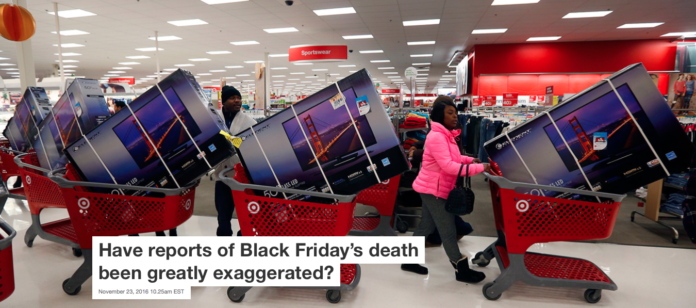
Jay L. Zagorsky, The Ohio State University
Black Friday is hyped as one of the biggest in-store shopping days of the year, with stores trumpeting giant sales and even bigger advertising campaigns.
Some pundits claim that Black Friday is dying and is no longer relevant. However, the National Retail Federation issued a strong denunciation of these articles and declared that Black Friday is “far from gone.”
Which is the true story? Is Black Friday dying or still relevant? These questions are important because some retailers believe Black Friday helps get people in the mood for spending over the holiday season, when U.S. companies make approximately one fifth of their annual sales.
To answer them, let’s consider four important facts and data points concerning Black Friday. Together, they paint a mixed picture.
Four facts to ponder
First, lots of people go out shopping on Black Friday
Each year the National Retail Federation issues numbers showing how many people plan to begin shopping the moment they finish devouring their Thanksgiving pie. Last year 66 million adults said they would definitely go shopping on Thanksgiving weekend, while another 70 million said “maybe.” And 74 percent of them planned to shop on Black Friday. When you have 136 million people intending to do the same thing at the same time, it’s clear the day remains important.
Second, we are spending less time shopping.
One measure of something’s importance is how much time is spent on the activity. Important things get attention and time. The latest data, however, show we are spending less time shopping, suggesting it’s becoming less important to us.
The U.S. government began surveying people in 2003 to find out how much time we spend on daily activities, such as sleeping, working, taking care of children, watching television and countless other tasks, using the American Time Use Survey. The typical adult spent 146 hours per year shopping in 2003. By 2015, the figure had dropped to 131 hours, a reduction of 15 hours or 10 percent.
To give some perspective on how much time we spend shopping, the average person in the U.S. spends about 250 hours a year showering, brushing their teeth, combing their hair and doing other personal grooming. Shopping comprises about half the amount of time we spend cleaning ourselves up.
Where did we cut back? Of the total 15-hour drop, people in the U.S. spent five fewer hours shopping for groceries and food. Shopping for clothes, shoes, toys and all the other items people buy dropped by 10 hours, which bodes ill for Black Friday’s importance.
Third, we are not spending less
One potential reason we are devoting less time to shopping is that the average person is spending less. If you buy less, you do not need to spend as much time shopping. Data from the U.S. Census Bureau’s Retail Trade Surveys show this reason is not true.
After adjusting for inflation, the average person in the U.S. spent a bit under US$15,000 in 2003 on retail goods. That figure had budged a small amount a dozen years later but was still below $15,000. This fact is neither good nor bad for Black Friday’s fate.
Fourth, internet shopping is taking sales away
One big reason we are spending less time shopping is that instead of going to physical stores we are buying items online. Shopping online is often much faster than wandering the aisles aimlessly in a giant big-box emporium.
While overall spending has not increased, the Census Bureau’s retail data show people in the U.S. are steadily shifting away from buying things in stores toward buying on the internet. In 2003 the average U.S. person bought slightly more than $250 of goods on the internet. By 2015, the figure had jumped to almost $1,100 per person.
This steady growth in e-commerce follows almost the same downward trend in sales at brick-and-mortar locations strongly suggesting people are just shifting from one method of shopping to another. This final fact is another ill omen for Black Friday (and shows the increasing prominence of Cyber Monday).
So what is the answer?
Black Friday sales will continue to pack in the crowds for three reasons.
First, sales spike on Friday because of a catchup effect. Almost no one goes retail shopping on Wednesday, the day before Thanksgiving, when large numbers of people are traveling. On Thanksgiving Day itself, most retail stores are closed. Even without special sales, this catchup effect ensures the day after Thanksgiving has a larger volume of traffic and more robust revenue than a typical Friday.
Second, many people get the day after Thanksgiving off from work since most non-retail businesses, schools and government offices are closed or functioning only with skeleton crews. For people who have gotten their fill of family and turkey, going shopping is a welcome excuse to leave the house.
Third, the media’s focus on the day helps ensure it is an experience that people want to join. No matter what the other trends in retail data show, the days after Thanksgiving are often very slow news days, since many business people and politicians, who generate news, take the day off. With less to report, journalists will continue to focus on Black Friday since it is something they know will happen and will attract attention.
So is Black Friday dying or booming? The National Retail Federation’s data show lots of people went shopping just after Thanksgiving. Census data show steadily lower sales in bricks and mortar stores year after year, plus rising internet sales. Time use data show shopping is now taking less of the typical person’s day.
My answer is that while brick-and-mortar stores are slowly becoming less relevant for daily purchases, people love events. Black Friday in the future will likely become more of a special occasion where many people go back to retail stores that in their day-to-day life they will typically ignore.
![]()
Jay L. Zagorsky, Economist and Research Scientist, The Ohio State University
This article was originally published on The Conversation. Read the original article.




















